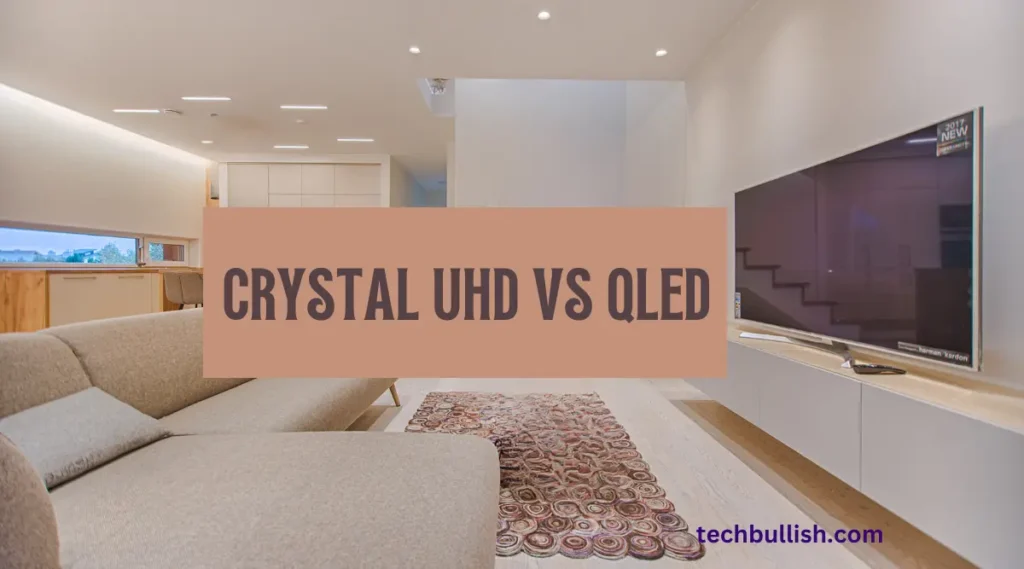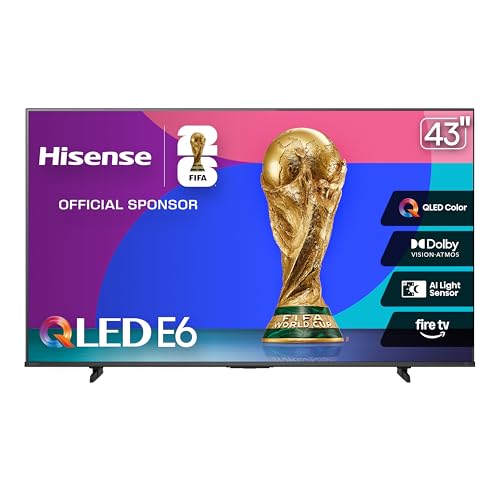When it comes to buying a new Smart TV, there are many factors to consider, including screen size, resolution, and display technology. Two popular display technologies available in the market are Crystal UHD and QLED.
Here is the difference between Crystal UHD and QLED.
Samsung Crystal UHD, also known as 4K UHD, uses LCD panels with LED backlighting to produce high-quality images with excellent resolution and color reproduction. While QLED, which uses quantum dot technology, offers superior color accuracy, brightness levels, deeper blacks, and wider viewing angles, it is typically more expensive than Crystal UHD.

Let’s get started to know the differences of these displays and decide which is a better choice!
Samsung Crystal UHD Vs QLED
| Feature | Samsung Crystal UHD | Samsung QLED |
| Brightness | Good | Excellent |
| Contrast | Average | Excellent |
| Picture Quality | Good | Great |
| Resolution | Upto 4k | Upto 8k |
| Technology | LCD with LED Backlighting | Quantum Dot technology |
| HDR support | Present in most Crystal UHD TVs | Present in most QLED TVs |
| Processor Used | Crystal 4k Processor | Quantum Dot Processor(Quantum Processor Lite 4K/ Quantum Processor 4k/Neo Quantum Processor 4k specifically for Samsung) |
| Color Output & Accuracy | Good | Vivid and Lifelike |
| TV Price | Affordable | More Expensive |
| Energy Efficiency | Lower | Higher |
| Gaming Performance | Great | Better than Crystal UHD for gaming due to lower input lag. |
| Viewing Angle | Average | Excellent |
What Is Samsung Crystal UHD?
Crystal UHD is a marketing term for Samsung to describe a specific series of their television model. Also, the Crystal UHD is their cheaper range of televisions to differentiate from their more expensive QLED and OLED lines.
The “UHD” in Crystal UHD stands for “Ultra-high-definition,” which means that these TVs have a resolution of 3840 x 2160 pixels, which is commonly referred to as “4K.”
Samsung markets a special Crystal 4k image processor that can take the image ahead of a standard 4k TV. This upscales the image further and has excellent color mapping to get your TV’s more realistic color output. They call the color Dynamic Crystal Color or PurColor.
While Crystal UHD TVs may not have all the bells and whistles of Samsung’s more expensive lines, they still offer a high-quality viewing experience at a more affordable price point.
Pros:
- High resolution of 4K provides excellent picture quality
- Advanced color processing and wide color gamut produce rich, vivid colors
- Game Enhancer optimizes TV settings for gaming and reduces input lag
- Dynamic Crystal Color technology enhances color accuracy and brightness
- Affordable compared to other high-end TV technologies
Cons:
- May not have the same level of color accuracy and brightness as QLED TVs
- May not have the same level of AI processing as Quantum Processor 4K in QLED TVs
What Is QLED?
QLED stands for “Quantum Dot Light Emitting Diode”. It is a display technology used in modern televisions that enhances color accuracy and brightness levels. QLED TVs use quantum dots, which are tiny particles that emit light when excited by energy.
When light passes through these particles, it produces a wider range of colors and more accurate hues. QLED technology also offers better viewing angles and deeper blacks than traditional LCD panels.
Samsung is one of the leading manufacturers of QLED TVs, but other companies such as Sony and LG have also started using this technology in their products. Overall, QLEDs are a great option for those who want a TV with excellent color accuracy, brightness, and contrast.
In a nutshell, QLED TVs are self-emitting with a Quantum Dot film that produces a vibrant range of color and impressive contrast – with no color filters.
Pros:
- Quantum Dot technology produces a wide color gamut and accurate colors
- Quantum HDR enhances contrast and color accuracy in bright and dark scenes
- Quantum Processor 4K uses advanced AI algorithms to enhance image quality and reduce noise
- FreeSync technology reduces screen tearing and provides a smoother gaming experience
- Brightness of up to 2000 nits provides excellent visibility in even the brightest rooms
Cons:
- More expensive than Crystal UHD TVs
- May not have the same level of upscaling performance as some other high-end TV technologies
- May not have the same level of viewing angle as some other high-end TV technologies.
Color Output Comparison
When it comes to color output, both Crystal UHD and QLED TVs offer exceptional performance. However, there are some differences between the two technologies.
Crystal UHD TVs use a combination of advanced color processing and a wide color gamut to produce rich, vivid colors. They also feature a technology called Dynamic Crystal Color, which uses a special film layer to enhance color accuracy and brightness.
On the other hand, QLED TVs use Quantum Dot display technology to produce a wide color gamut and bright, accurate colors. They also feature a technology called Quantum HDR, which enhances contrast and color accuracy in bright and dark scenes.
Overall, both technologies offer excellent color performance, but QLED TVs may have a slight edge in terms of color accuracy and brightness.
Viewing Experience Comparison
Both Samsung Crystal UHD and QLED TVs offer an immersive viewing experience, with large screens, high resolution, great refresh rate, and advanced picture processing technologies.
Crystal UHD TVs offer a resolution of 4K, which provides four times the resolution of Full HD.
They also feature advanced upscaling technologies, which can enhance the quality of lower resolution content.
QLED TVs also offer 4K resolution, along with advanced picture processing technologies like Quantum HDR and Quantum Processor 4K. They also offer a wider viewing angle than Crystal UHD TVs, which means that viewers can enjoy the same picture quality from a wider range of angles.
Overall, both technologies offer an excellent viewing experience, but QLED TVs may have a slight edge in terms of picture processing and viewing angle.
Processor Comparison: Crystal Processor 4k vs Quantum Processor 4k
The processor is an important component of any TV, as it is responsible for processing the image and producing the final picture.
Samsung Crystal range of TVs feature Crystal Processor 4K, which uses advanced algorithms to enhance the image quality and reduce noise. It also features an upscaling engine, which can enhance the quality of lower resolution content.
QLED TVs feature Quantum Processor 4K, which uses advanced AI algorithms to enhance the image quality and reduce noise. It also features an upscaling engine, which can enhance the quality of lower resolution content.
Overall, both the processors offer excellent performance, but Quantum Processor 4K may have a slight edge in terms of AI processing and upscaling.
Gaming Experience Comparison
Both Crystal UHD and QLED TVs offer excellent gaming performance, with low input lag and fast response times.
Crystal UHD TVs feature a technology called Game Enhancer, which optimizes the TV settings for gaming and reduces input lag. They also feature a motion rate of 120Hz, which provides smooth, blur-free motion during fast-paced games.
QLED TVs also feature Game Enhancer, along with a technology called FreeSync, which synchronizes the refresh rates of the TV with the frame rate of the game console. This reduces screen tearing and provides a smoother gaming experience.
Overall, both technologies offer excellent gaming performance, but QLED TVs may have a slight edge in terms of screen tearing reduction and smoother motion.
Picture Quality Comparison of Crystal UHD and QLED TVs
Both Crystal UHD and QLED TVs offer exceptional picture quality, with high resolution, advanced color processing, and HDR support which is great for media consumption.
Crystal UHD TVs use a combination of advanced color processing and a wide color gamut to produce rich, vivid colors. They also feature a technology called Dynamic Crystal Color, which enhances color accuracy and brightness.
QLED TVs use Quantum Dot technology to produce a wide color gamut and bright, accurate colors. They also feature a technology called Quantum HDR, which enhances contrast and color accuracy in bright and dark scenes.
Overall, both technologies offer excellent picture quality, but QLED TVs may have a slight edge in terms of color and contrast.
Brightness and Color Output Comparison of Crystal UHD TV and QLED TVs Display
Both Crystal UHD and QLED TVs offer exceptional brightness and color output, with advanced technologies that enhance the viewing experience.
Crystal UHD TVs feature a technology called Dynamic Crystal Color, which uses a special film layer to enhance color output and brightness. They also feature a brightness of up to 1000 nits, which provides excellent visibility in bright rooms.
QLED TVs use Quantum Dot technology to produce bright, accurate colors, along with a technology called Quantum HDR, which enhances contrast and color output in bright and dark scenes. They also feature a brightness of up to 2000 nits, which provides excellent visibility in even the brightest rooms.
Overall, both technologies offer excellent brightness and color output, but QLED TVs may have a slight edge in terms of brightness. If you compare side by side you will definitely notice Crystal UHD TVS have poor brightness/black levels compared to the QLED TVs.
Which is Better Between Samsung’s Crystal UHD and QLED TV?
QLED is considered better than Crystal UHD in terms of overall performance, as it has more advanced features and better performance.
However, Crystal UHD TVs are more affordable than QLED models and offer a good viewing experience with improved color accuracy and brightness.
The decision ultimately depends on personal preference and budget.
Some awesome Crystal UHD TVs that you can check:
Last update on 2025-10-23 / Images from Amazon Product Advertising API
Some great choices of QLED TVs that you can check:
Last update on 2025-10-23 / Images from Amazon Product Advertising API
Frequently Asked Questions
What are the Differences between Samsung Crystal UHD and QLED?
What are the benefits of Samsung Crystal UHD TV?
What are the benefits of buying a QLED TV?
Is Crystal Ultra HD better than QLED?
Conclusion
Let’s conclude the post!
Both TV technologies have advantages and disadvantages.
However, as per budget and other requirements, you need to pick one according to your need.
I hope you enjoyed reading this post.

I’m Anirban Saha, Founder & Editor of TechBullish. With a B.Tech in Electronics and Communication Engineering, and 6+ years of experience as a software developer, I have expertise in electronics, software development, gadgets, and computer peripherals. I love sharing my knowledge through informational articles, how-to guides, and troubleshooting tips for Peripherals, Smart TVs, Streaming Solutions, and more here. Check Anirban’s Crunchbase Profile here.





